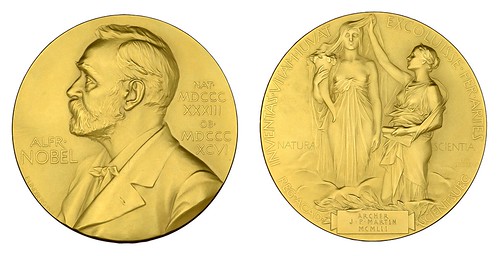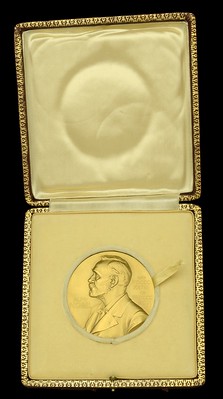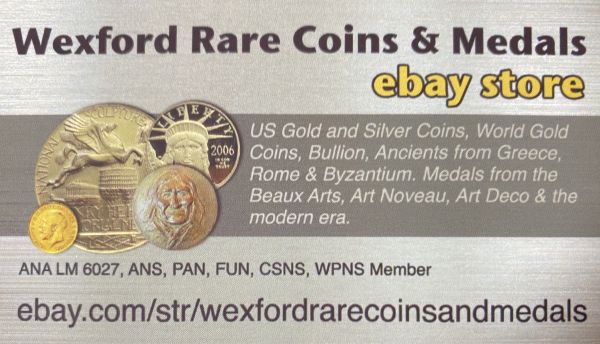
PREV ARTICLE
NEXT ARTICLE
FULL ISSUE
PREV FULL ISSUE
V25 2022 INDEX E-SYLUM ARCHIVE ARCHER MARTIN NOBEL PRIZE IN CHEMISTRYNoonan's is offering a Nobel Prize in Chemistry and other important medals of Archer Martin. Here's an excerpt from the press release. -Editor The Nobel Prize medal awarded to the astonishing and inspiring chemist Archer Martin in 1952 will be sold by Noonans on Thursday, February 2, 2023 in a sale of Coins and Historical Medals. It is being sold by his family and expected to fetch £100,000-150,000. As Peter Preston-Morley, Special Projects Director in the Coins department at Noonans commented: Archer Martin was a brilliant scientist whose discoveries led to extraordinary advances in medicine and other fields and won him the Nobel Prize for Chemistry in 1952, but cruelly could not help his own mental decline. He was a fearless guinea pig for drug testing to transform the lives of Alzheimer's sufferers and delighted researchers when his condition improved. The public first became aware of Archer's genius when he shared the Nobel Prize for Chemistry in 1952 with Richard Synge for their ground-breaking invention of Partition Chromatography, an effective method of separating compound elements that had far-reaching implications for analytical chemistry.
Archer suffered with stomach ulcers. During the War he was allowed extra milk as an anti-inflammatory. When his ulcer became very troublesome in later life, he was puzzled that milk then proved ineffective. Learning that pasteurisation methods had changed, he experimented with unpasteurised milk but was annoyed to find himself putting on weight. He decided to separate the milk and found the active ingredient in the whey, which he could then concentrate. He persuaded various companies to test the extract which they found effective at calming inflammation. He demonstrated this himself by burning his arms with cigarettes, but they refused to invest in his discovery because, whey being a natural product, it could not be patented.
Archer, a teetotaller, was amused to realise his work had made possible the breathalyser. The Nobel Prize was his most distinguished award, but by no means the only one that will be offered by Noonans in February. The full list is as follows: Nobel Laureate for Chemistry (1952), Japanese Order of the Rising Sun (1972), The Companion of the British Empire (1960), The Royal Society Leverhulme Medal (1963), The John Scott Award (1958), The Merck Connecticut University Randolph Major Medal (1979), The Mikhail Tswett Medal (1976), The Callendar Medal (1971), The Franklin Institute Medal / John Price Wetherill Medal (1959), The Fritz Pregl Medal (1985), The Jacobus Berzelius Medal of the Swedish Medical Society (1951), The John Price Wetherall Medal / Franklin Institute (1959), The Kolthoff Medal (1969). Archer John Porter Martin, CBE, FRS (1910-2002), b. London; educ. Oaklands School Crouch End, Bedford School and Peterhouse, Cambridge; researcher at Dunn Nutritional Laboratory, Cambridge, 1933-8; moved to Leeds to work at the Wool Industries Research Association, Headingley, where, with Richard Synge, he invented partition chromatography, one of the most powerful analytical techniques ever developed for separating and identifying the components of complex mixtures, their invention in 1944 arising from research on analysing the amino acid components of wool fibre; director of biochemical research at Boots, Nottingham, 1946-8; Medical Research Council, Lister Institute, Mill Hill, London, 1948-57, appointed head 1952; FRS 1950; purchased Abbotsbury House, Elstree, with his Nobel prize money, establishing Abbotsbury Laboratories Ltd, 1959; CBE 1960; consultant to Wellcome Medical Research, Beckenham, 1970-3; professorial appointments at the University of Sussex 1973-4, Houston University 1974-9 and the E´cole Polytechnique, Lausanne, 1979-80; retired to Llangarron, Herefordshire. Recent Nobel Prize Medals sold include: Dimitry Muratov, Nobel Peace Prize for 2021 ($103.5m, June 2022); Walter Kohn, Nobel Prize for Chemistry, 1998, ($457,531, January 2022).
For more information, see:
Wayne Homren, Editor The Numismatic Bibliomania Society is a non-profit organization promoting numismatic literature. See our web site at coinbooks.org. To submit items for publication in The E-Sylum, write to the Editor at this address: whomren@gmail.com To subscribe go to: https://my.binhost.com/lists/listinfo/esylum All Rights Reserved. NBS Home Page Contact the NBS webmaster 
|




